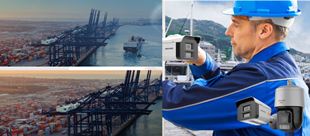08/01/2011
U.S Marine Resources select Bosch surveillance to protect vast coastline
Gulf Coast, Alabama (USA)
Alabama’s Marine Resources Division enlisted the assistance of the U.S. Space and Rocket Center/Geospatial Training and Application Center (GTAC) to design a ruggedized video surveillance solution that would be easily accessible to all of its law enforcement personnel in the field. The system produces useable images in light, dark and foggy conditions. The system enables Marine Resources Division officers to remotely view video and still images from MIC cameras and control pan, tilt, zoom functions, using a smart phone or laptop computer, to investigate potential security risks. Featuring up to 36x optical zoom, the MIC cameras enable officers to identify vessels and read markings on ships nearly two miles away. And, with dual thermal/optical operation, the MIC Series 412 cameras provide round-the-clock surveillance.
With more than 750 square miles in Mobile Bay and 11,000 square miles in the Gulf of Mexico patrolled by less than 20 officers, the video system helps secure strategic locations throughout the area.
“The Coastal Remote Monitoring System is a force multiplier,” said Major Chris Blankenship, acting director for the Alabama Department of Conservation and Natural Resources, Marine Resources Division. “In one incident, our officers were able to remotely investigate a suspicious vessel near a chemical plant and determine the boat was not a threat. Having mobile access to video from the MIC security cameras saved the officers 50 miles of boating and several man-hours.”
Using fibre and wireless connections, the security cameras send video to Zaibot appliances created by Crystal Data. The appliances convert video to the format preferred by the individual user. “The Zaibot appliances allow the law enforcement officers to have access to video or still images from the cameras whether they are on a boat, in a car, or at the Marine Resource Division’s central office,” said Tim Erwin, president, Crystal Data.
The system records all video and retains it for extended periods. Archived video is watermarked with the department’s logo and stamped with the location, date and time and can be used as evidence for legal proceedings.
“Many of the currently installed locations push the capability and functionality of the MIC security cameras to the maximum, and we have been thrilled at the way they perform,” said Chris Johnson, senior vice president, U.S. Space & Rocket Center/Geospatial Training and Application Center. MIC security cameras are designed to provide reliable, high-quality surveillance in tough environments. The cameras feature a six millimeter thick housing. The IP 68 rating makes them ideal for ports, industrial and critical infrastructure locations. An integrated silicone wiper enables the MIC Series to capture the highest quality images regardless of conditions.
Available in aluminum, stainless steel, certified explosion-protected, infrared and thermal versions, the MIC Series deliver absolute performance in a vast range of locations.

















